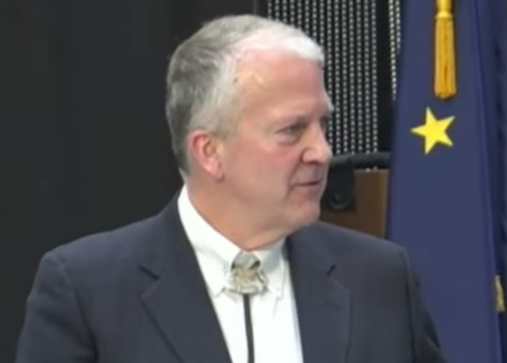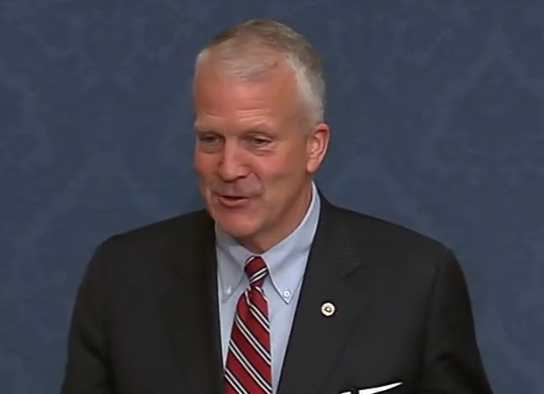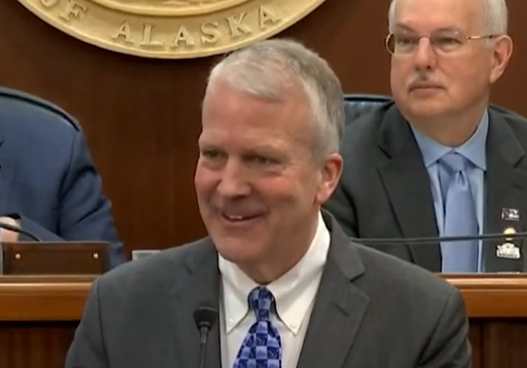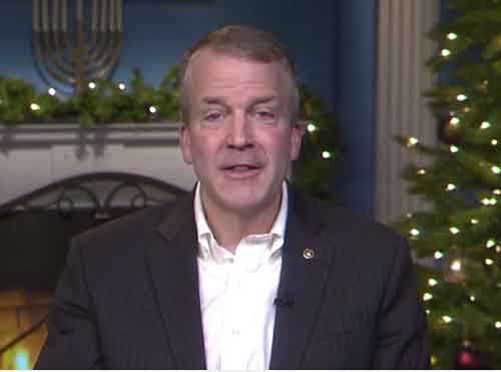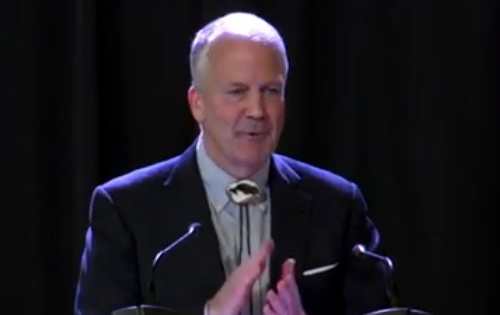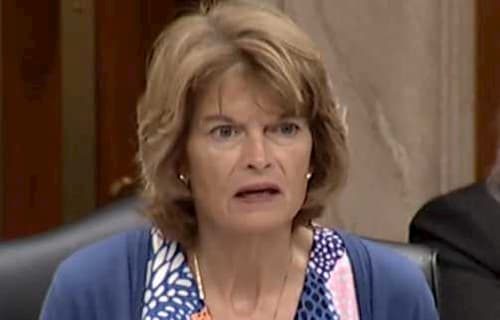VII. DOGE
Now, I want to address an issue that I’ve heard from a lot of you about: the Department of Government Efficiency, or DOGE.
Our national debt of over $36 trillion has reached dangerous, unsustainable levels. Last year, we paid out more in interest on this debt—upwards of $950 billion—than we did to fund our military at about $870 billion.
When you look at history, great powers begin to fail when they hit this precarious inflection point—spending more in interest on the debt than they do to protect their own nation. These debt and spending levels also drive high inflation rates, as we’ve seen over the past few years, which remain the top concern of Alaskan families—the high cost of living.
There is plenty of bipartisan blame to go around for this dangerous debt situation. I think most in this room understand that we have to root out wasteful spending, more responsibly spend the American people’s hard-earned dollars, and have a federal government that finally starts to live within its means. Otherwise, we’ll just be passing this mess onto our kids and grandkids. It is now a very significant threat.
Difficult choices need to be made. That’s what DOGE is doing, and they are making some notable progress. Do I like every decision that they’re making? No. But these are difficult decisions. Job losses are always difficult on families and communities, especially in tight-knit states like ours. They need to be done humanely and not randomly. But is the end goal of a smaller, more efficient federal government that lives within its means necessary at this point in time? Yes, and there has been a successful historical precedent.
President Clinton launched the National Partnership for Reinventing Government (NPRG) during his first year in office. Its goal was to dramatically shrink government and make it more efficient, which he did during his presidency. That initiative saved over $108 billion and it eliminated over 426,00 federal jobs during the Clinton administration.
These savings contributed to balancing the federal budget by 1998 under that administration. It was the first time and last time we actually had a budget surplus in decades.
I’ve spoken directly with DOGE leaders and Trump administration leaders regularly on this effort. They have emphasized that, during this process, there will be mistakes made, and they want to work with us to correct them. We have had some successes on getting decisions that were made, or going to be made—on things like GSA leases and frozen federal spending—we’ve had success in turning those around. The way we’ve been doing it is emphasizing that executive order I gave you.
If there is a decision that you’re seeing that’s being made—and we’re trying to track all of them—that impacts safety in Alaska or impacts our economy, we’ve been going to them and saying, “Look at that EO. You can’t do that. You need to reverse it.”
Also in your handouts, there is a form. Take a look at it. If there are decisions on federal spending, or GSA leases, or federal employees, and you can make the argument to us, we’ll work with you, that that’s going to undermine our economy or safety, we will work it. Like I said, we’ve had some success on turning these things around when we think it negatively impacts those issues in our state. So we want to work with you on that.
VIII. Energy / Alaska Gasline
Let me conclude where I began. This [Last Frontier Lock-Up document] was a dream killer for Alaska. A federal government spending a heck of a lot of its time, with 70 executive orders—and tried to do more—shutting down our economy and jobs. This [Alaska-specific Trump’s EO], in my view, is a dream maker. We need to seize the big opportunities before us, together.
Several years ago, when I was DNR Commissioner, my team and I put forth the vision of a million barrels a day running through TAPS. This vision depended on a fair, stable fiscal regime, less burdensome state and federal regulations, and very importantly, a federal government that opened land to Alaska and cooperated with all of us.
The naysayers, not surprisingly, ridiculed this vision. But DNR recently estimated an official forecast of close to 670,000 barrels per day and a high forecast of 931,000 barrels a day by 2034. That’s good news. Not bad. No matter where you are on that, that will make your job a lot easier.
By the way, in the gallery today are Bill and Liz Armstrong of Armstrong Oil & Gas. Their wild-cat exploration activities—against very big odds over the last 20 years—have played an important role in this North Slope renaissance. I want to thank the Armstrongs very much.
An even bigger dream that has eluded our collective grasp for decades might also be a possibility now—the Alaska LNG Project.
As an Alaskan state and federal official, like many of you, I’ve been working on this project for over 15 years—it feels like most of my life—including when our Legislature passed the law establishing AGDC in 2013 and in 2014, keeping the project moving. In a number of my speeches to the Legislature, including last year, I’ve provided updates on this project: federal permits and billions of dollars in federal loan guarantees we’ve secured, foreign government interest in the project, and growing stakeholder alignment.
Now, truth be told, I saw the eye-rolling from some of you: “Sure, Dan, we’ve been hearing about this for decades.” I understand the skepticism, because we have been hearing about this for decades. But from my perspective, the transformative benefits to our state are so huge and the geostrategic imperative for America and our Asian allies so compelling, that my team and I have, for years, kept ramming our shoulders into the cement wall of Alaska LNG, hoping someday that one of the cinder blocks in that wall would give way.
This fall, I took my fourth trip to Japan and Korea in the last two years touting this project. I’ve hosted hundreds of meetings with energy companies, financiers, our own federal government officials, and, of course, Asian LNG importers, and government leaders from these countries.
Sometimes I’ve asked myself, is this really worth the effort or is it a futile endeavor, particularly with stonewalling from the Biden administration, including Biden’s climate czar, John Kerry, who unbelievably went overseas to tell our Asian allies not to buy American or Alaskan gas! Not good.
But we continued ramming against the AK LNG wall and, of late, a crack has developed—an 800-mile crack in this wall that shows undeniable progress.
It started with another handout that I have in your materials—this one on AK LNG. After the November election, I was in a meeting with President Trump, and I gave him, his national security advisor, his chief of staff, this document and directly pitched him and all of his team—and I’ve used this document to pitch all of his cabinet officials—even the ones who know nothing about energy—and his top officials on the huge benefits of this project to America. I said, “We need your full backing and support of this, Mr. President.”
I think you’ve seen, we’ve gotten it.
Take a look at the Trump administration day-one executive order again. AK LNG is mentioned twice as a priority for the United States of America. That is a really big deal.
Then, in the President’s first meeting with the Prime Minister of Japan, he and his Secretaries of Interior and Energy spent about half the meeting pressing with Japan’s leadership pressing the AK LNG Project, including with maps and discussions. Then, the President highlighted our project in his joint press conference with the Prime Minister of Japan, saying, “We’re going to get this done. Right, Prime Minister?” I don’t think the Prime Minister answer that, but it was okay.
Then, even bigger than the Japanese Prime Minister meeting, about two weeks ago at the State of the Union address to a joint session of Congress, the President spoke these words:
“My administration is also working on a gigantic natural gas pipeline in Alaska—among the largest in the world—where Japan, South Korea, and other nations want to be our partner with investments of trillions of dollars each. There’s never been anything like that one. It will be truly spectacular. It’s all set to go. The permitting is gotten.”
When the President of the United States, the most powerful person and country in the world, who is known as a deal-maker, says a project is his priority, people listen. And most importantly for us, foreign governments listen.
Now, as you can imagine, none of this progress happens by accident. To get the President to mention your big project or idea in the State of the Union address is not very easy. It’s kind of a daunting task. I worked very closely with Governor Dunleavy and our teams to get that done, to get the executive order on Alaska done, and we’ve been working that hard. But here’s the really important thing. We’re pushing on an open door. This President and this administration—and you can see it almost daily—they want to help us—whether it’s AKLNG, or the NPR-A, or ANWR, or so many other things.
I was down in Houston last week with Governor Dunleavy and Secretary of the Interior Doug Burgum—who’s also the President’s chair of the National Energy Dominance Council—at CERA Week, one of the largest oil and gas conference in the world. Alaska LNG was the talk of this conference. That’s really important.
Now, the project is still not right around the corner, but the corner is in sight.
Why have my team and I been working on this so hard and so relentlessly? Because this project would transform our state. Imagine the possibilities, what we could achieve with a nearly inexhaustible supply of our own affordable, clean energy for the whole state. Imagine the private sector opportunities that could start here—a manufacturing base, thousands of good-paying jobs, a steady source of income for many years to come to our state’s coffers.
It’s too big, the transformative possibilities too great not try with everything we have. So we’re going to keep smashing into that wall.
By the way, for the naysayers and pessimists out there in the media and other places—and I know there are many—my question to you is: What is the alternative for the people we represent? Importing gas from Canada or a corrupt country like Mexico? If we do that, energy prices are going to double or triple for our homes, for our businesses, for our schools, for our hospitals. Low-cost energy will be closed for a generation, and good-paying jobs, and the possibilities that go with this project, will flee our state, and so will our kids.
The Trump administration, from the President on down, has made AK LNG a top priority. We want to work with you all. I respectfully ask that all of you to do the same.
I know you have a lot of hard work to do to make sure this project gets the proper scrutiny and due diligence, and that’s a big part of your job. But we have to move fast. We have an opportunity!
As you’re evaluating this project and thinking of creative ways to spur it, not stop it, I’m asking all of you—all of us collectively as Alaskans—to not lose sight of the vision that built our state. The vision that’s still brimming with strength, invention, energy, and opportunity.
As President Trump said about the gasline, “There’s never been anything like that one. It will be truly spectacular.” Working together at this moment of opportunity, we just might pull it off, and if we do, it would be truly spectacular for our state!
Thank you again. I appreciate working with all of you. It’s an honor of a lifetime to represent you and work with all of you as your United States Senator. Thank you.
[content id=”79272″]



